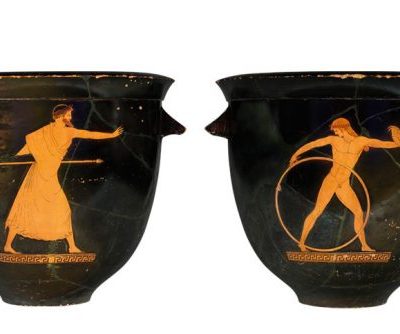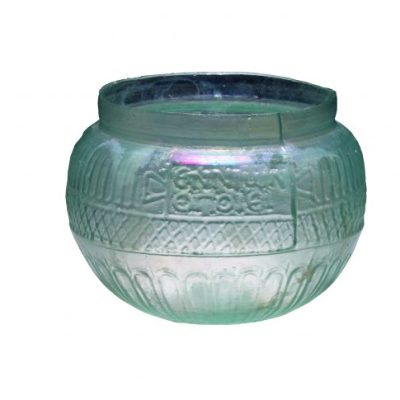A small cup, currently on display in the temporary exhibition ‘Drinking with the Gods’ at La Cité du Vin in Bordeaux, held a small surprise for any ancient Greek who’d finished sipping their wine and peered with sadness into its dry, empty interior. A satyr is painted within, his tail in the air as he dives head first into a vat of wine, his own tiny cup left below, untouched. Such behaviour was frowned upon in Greek society, I learn, because drinking wine was a divine affair, involving the proper rituals and respect for the gods, which separated the Greeks from the barbarians. The satyr, it seems, had forgotten his good manners. Luckily for us modern wine-drinkers, there’s no longer any risk of embarrassing ourselves like a drunken satyr, because this intoxicating exhibition explains how we can avoid insulting the Greek and Roman gods or appearing like barbarians.
With around 50 artefacts on display, including loans from the Louvre, ‘Drinking with the Gods’ centres on the role of wine in Greco-Roman culture, with a large part dedicated to Dionysus, the god who gave wine to humans and – perhaps more importantly – taught us to make it ourselves. Early on, there’s a statue of the god carved into the marble leg of a banqueting table. It shows Dionysus leaning against a pillar, naked, one arm over his head in a gesture of ecstasy (or possibly wondering where he’d last seen his clothes). With his other hand, he pours wine for his panther, his constant companion, present in various artefacts on display. Unmixed with water, the wine drank by panther and god alike was believed to drive mere mortals insane, the exhibition explains. This is useful advice for the Greek-god-fearing among us. The correct way to drink wine is to mix it with water in a large vase called a krater. Then, before taking a cup, you make an offering from it to the gods and say a prayer.
As you explore the exhibition, there’s a bronze image of Dionysus’s drunken mule (not a very efficient way of getting around, I imagine), and paintings and carvings of the satyrs that accompanied the god on his travels – men with goat or horse legs and animal ears. Women called the maenads (‘the mad ones’) were also part of the divinity’s troupe, and were believed to tear you apart if you didn’t welcome Dionysus correctly. It sounds like quite the party – so long as you followed the correct rituals and survived the night.
Further characters from Dionysus’s myths and adventures are also present. The sides of one Greek vase from 490 BC show Dionysus and Heracles meeting for a drinking competition. Pan makes an appearance as a small bronze figure, and we meet a marble statue of the satyr Silenus, Dionysus’s tutor, carved holding a large goatskin of wine. Festivals of Dionysus are represented too, such as the three-day-long Anthesteria (‘Flower Festival’), celebrating the god’s return and new wine; a scene of women offering to a statue of Dionysus during this festival can be seen on a jug from 450–440 BC. The exhibition also explores the god of wine’s incarnation as Bacchus under the Roman Empire.
One highlight is a replica of a huge vase from the 6th century BC discovered in a Celtic princesses’ tomb in France. This could hold 1,100 litres of wine and is apparently the largest known vase from the ancient world – standing before it, you can quite easily imagine diving inside like an ill-mannered satyr. Another reproduction shows a mosaic of a skeleton holding wine jugs, meant to remind banqueters to enjoy their lives.
Installation view of ‘Drinking with the Gods’, La Cité du Vin, Bordeaux, 2021. Photo: Anaka

But there’s more to the exhibition than the ancient artefacts. In one area, you can sit and listen to tales of Dionysus, as told by the slam artist and poet Maras, the words projected on to the walls. A video shows a banqueting scene from Federico Fellini’s film Satyricon (1969). Three modern installations have been created by street artists, inspired by the ancient myths. Atmospheric music drifts across the exhibition space. The imagery on one Italian situla, showing King Maron hosting Dionysus and receiving a vine and drinking vessel in return, has been replicated on a large scale in fabric, which makes its theme – the gift of wine – much clearer, and makes you feel immersed in the scene.
The exhibition is moodily lit with spotlights, creating stark contrasts between dark spaces, the illuminated objects, and the green-themed information panels and labels, which present the objects and their backgrounds in a refreshingly clear, engaging and sometimes almost conversational manner. Interesting cultural details are included throughout – among them, that during the Anthesteria, the Greeks held competitions in which people tried to down their cups of wine in a single gulp.
All of which adds up to a rather delicious blend, mixing old flavours with something new. With the world now slowly opening up again, if you can make it to Bordeaux, ‘Drinking with the Gods’ is an exhibition that you should sample while you still have the chance. And when enjoying a glass of wine afterwards, remember to offer a little to Dionysus.
‘Drinking with the Gods’ is at La Cité du Vin in Bordeaux, France, until 7 November.



